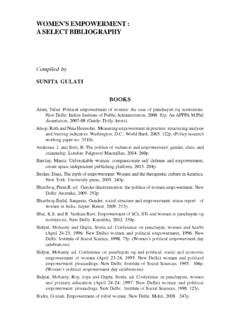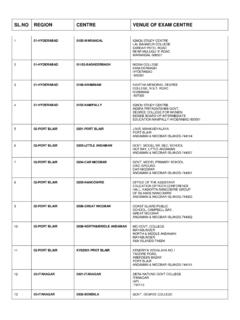Transcription of WOMEN EMPOWERMENT THROUGH …
1 WOMEN EMPOWERMENT THROUGH . reservation IN panchayati RAJ. institutions IN himachal pradesh . SIMMI AGNIHOTRI AND VIJAY SINGH. The WOMEN constitute half of the society. The feudal attitudes of looking down upon the abilities of WOMEN and not promoting them is still continuing in different degrees at various levels of our society. Present article is an attempt to analyse the situation of WOMEN representation in panchayati Raj institutions (PRIs) in himachal pradesh . With the increasing violence against WOMEN in our society, it becomes necessary to find out the problems of our society regarding WOMEN and give valuable suggestions to deal with the problem. To give the representation to the WOMEN in local self-government is also a step to move forward in the direction of WOMEN EMPOWERMENT . Our society cannot run without WOMEN . A. woman plays several roles like mother, wife, sister, and daughter in our society.
2 Therefore, it is the duty of everyone to respect them equally. INTRODUCTION. THE CONCEPT of WOMEN EMPOWERMENT has predominantly become a focus on political participation. The latter in turn in the context of the debate on the 81st Constitutional Amendment Bill regarding reservation for WOMEN in Parliament, has become a restricted discourse on the role of woman in formal representative institutions of decision-making, whether it is panchayati Raj Institution or Parliament. In the process, EMPOWERMENT of WOMEN emerges as an extremely limited concept. The fact that EMPOWERMENT should imply a power to participate in the decision-making in all spheres of society, with no separation of the public and private and in all social, political, economic and cultural processes in society is completely obfuscated. The potentials of WOMEN remain largely unrecognised and their contributions are often overlooked.
3 Several factors are responsible for WOMEN 's low participation. The most important ones are literacy, traditionalism, prejudices, economic 418 / INDIAN JOURNAL OF PUBLIC ADMINISTRATION. 418 / VOL. LX, NO. 3, JULY-SEPTEMBER 2014. dependency and the unfavourable political structure, with its high rate of predominantly male incumbency and slow turnover. The dire need today is to remove the disparity between WOMEN 's formal political equality and their meaningful exercise of political power. 2001 was the year of EMPOWERMENT of WOMEN and was celebrated all over the world. We are now into the new century. The challenge before us now is not to just talk about the gender equality and awareness, but to initiate the process of transforming societies to turn away from gender discrimination . EMPOWERMENT includes overall development in terms of education, employment, legislative powers, decision- making power and health and awareness.
4 panchayati Raj institutions in himachal pradesh panchayati Raj system in himachal pradesh was established under the provision of the himachal pradesh panchayati Raj Act, 1952. Only 280 Gram Panchayats existed prior to the enactment of this Act. However, after the enactment of this Act 466 Gram Panchayats were established in the year 1954 and the numbers of Gram Panchayats were increased to 638 during the year 1962. On November 1, 1966, the hilly area of Punjab was merged in this state and consequently the number of Gram Panchayats increased to 1695. In the merged area, a three tier panchayati Raj System was in existence under the provisions of Punjab Panchayat Samiti and Zila Parishad Act, whereas two-tier system was prevalent in the State of himachal pradesh . With a view to bring uniformity in the panchayati Raj system in the old and the newly merged areas, the himachal pradesh panchayati Raj Act, 1968 was enacted on November 15, 1970 and the two-tier panchayati Raj system was established throughout the state.
5 Besides this the Nayaya Panchayats were also in the existence in the state for discharging judicial functions, but during the year 1977 Nayaya Panchayats were abolished and the judicial functions were transferred to the Gram Panchayats. After the enactment of the said Act in the year 1970 the existing Gram Sabhas were recognised or bifurcated from time- to-time and new Gram Sabhas/Gram Panchayats were established. During the year 2005-2006 Government created 206 new Gram Sabha circles, thereby raising the number to 3243 Panchayats. At present there are 3243. Gram Panchayats, 77 Panchayat Samitis and 12 Zila Parishads constituted in the State. Enactment of State panchayati Raj Act With a view to bring law relating to the Panchayats in conformity with the provisions of the 73rd Constitutional Amendment Act, the himachal pradesh panchayati Raj Act, 1968 has replaced and the himachal pradesh panchayati Raj Act, 1994 was enacted with effect from April 23, 1994.
6 Since the enactment of the himachal pradesh panchayati Raj Act, 1994, it has been amended 13 times as shown in Table 1. TABLE 1. Sr. Title Bill No. Act No. Date of Sections Amended No. Enactment 1. The H. P. panchayati Bill No. 3 of Act No. 10 of 3, 77, 88, 124, 167. Raj (Amended) Act, 1997 1997. 1977. 2. The H. P. panchayati Bill No. 17 Act No. 1 of 1, Addition of Chapter VI-A (Section Raj (2nd Amended) of 1997 1998 97-A to 97-I). Act, 1977. 3. The H. P. panchayati Bill No. 12 Act No. 18 of 2, 8, 15, 22, 78. 79, 80, 84, 89, 90, 91, Raj (Amended) Act, of 2000 2000 92, 93, 95, 101, 114, addition of 2000. Sections 12-A and 121-B 122, 145, addition of Chapter X-A and sections, 160-A to 160-E and 163-A, 179, 180, 181, 182, 200. 4. The H. P. panchayati Bill No. 20 Act No. 4 of 2, 5, insertion of Section 7-A, 13, 110, Raj (2nd Amended) of 2000 2001 131, 138, 184, 185. Act, 2000.
7 5. The H. P. panchayati Bill No. 10 Act No. 22 of 8, 11, 23, 78, 118, 168, 174, 175, Raj (Amended) Act, of 2001 2001 insertion of 175-A & 175-B, 181, 2001. substitution of Schedule-I. 6. The H. P. panchayati Bill No. 5 of Act No. 10 of 3, 71, 122, 140, 145. Raj (Amended) Act, 2002 2002. 2002. SIMMI AGNIHOTRI AND VIJAY SINGH. 7. The H. P. panchayati Bill No. 10 Act No. 17 of Insertion of section 5-A, Amendment Raj (Amended) Act, of 2005 2005 of sec. 7, 8, 9, 15, 23, 78, 89, 99, 122, WOMEN EMPOWERMENT THROUGH reservation / 419. 2005. 129, 145, 146, 153 to 155. 8. The H. P. panchayati Bill No. 15 Act No. 20 of 2, insertion of Section 11-A. Raj (Amended) Act, of 2006 2006. 2006. The H. P. panchayati Bill No. 11 Act No. 15 of 185. 9. Raj (Amended) Act, of 2007 2007. 2007. 10. The H. P. panchayati Bill No. 9 of Act No. 10 of 2, 8, 78, 89, 99, 125 and 129. Raj (Amended) Act, 2008 2008.
8 2008. 11. The H. P. panchayati Bill No. 16 Act No. 17 of 1, 145, 163 and 181. Raj (2nd Amended) of 2008 2008. 420 / VOL. LX, NO. 3, JULY-SEPTEMBER 2014. Act, 2008. 12. The H. P. panchayati Bill No. 7 of Act No. 15 of 2, 4, 5, 7, 7-A, 115, 118, 138 and 144. Raj (Amended) Act, 2010 2010 and Substitution of Section 181. 420 / INDIAN JOURNAL OF PUBLIC ADMINISTRATION. 2010. 13. The H. P. panchayati Bill No. 40 Act No. 9 of 98 and 122 and Substitution of Section Raj (2nd Amended) of 2010 2011 100 and 118. Act, 2010.. WOMEN EMPOWERMENT THROUGH reservation / 421. SIMMI AGNIHOTRI AND VIJAY SINGH. Various Laws Enacted in himachal pradesh The following laws enacted by the panchayati Raj Department of the State Government: 1. The himachal pradesh panchayati Raj Act, 1994. 2. The himachal pradesh panchayati Raj Act, (Election) Rules, 1994. 3. The State Election Commissioner (Condition of Service) Rules, 1994.
9 4. The himachal pradesh panchayati Raj (General) Rules, 1997. 5. The himachal pradesh panchayati Raj (Finance, Budget, Accounts, Audit, Work, and Allowances), 2002. 6. The himachal pradesh panchayati Raj (Appointment and Conditions of Service of Panchayat Sahayaks) Rules, 2008. 7. The himachal pradesh panchayati Raj (Appointment and condition of Services of Junior Scale Stenographers in Zila Parishads) Ruled, 2009. 8. The himachal pradesh panchayati Raj Act, 1994 (Extension to the Scheduled Areas) Rules, 2011. WOMEN 's reservation under 73rd Constitutional Amendment Act, 1992. This has added a new Part-IX to the Constitution of India. It is entitled as The Panchayats' and consists of provisions from Articles 243 to 243 O. In addition, the Act has also added a new Eleventh Schedule to the Constitution. This Schedule contains 29 fundamental items of the Panchayats. It deals with Article 232-G.
10 The act is a significant landmark in the evolution of grassroots democratic institutions in the country. It transfers the representative democracy into participatory democracy. It is a revolutionary concept to build democracy at the grassroots level in the country. The Act provides for the reservation of not less than one-third of the total number of seats for WOMEN (including the number of seats reserved for the SCs and STs). Further not less than one-third of the total number of offices of chairpersons in the Panchayats at each level shall be reserved for WOMEN . This would be rotated among different Panchayats at each level. The Act also authorises the legislature of a state to make any provision for reservation of seats in any Panchayat or offices of chairperson in the Panchayat at any level in favour of backward classes. reservation for Office Bearers in PRIs in himachal pradesh It is also the way to empower the WOMEN by providing them an opportunity to come forward THROUGH reservation for electing for the seats in PRIs.









